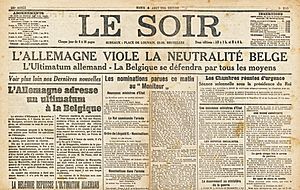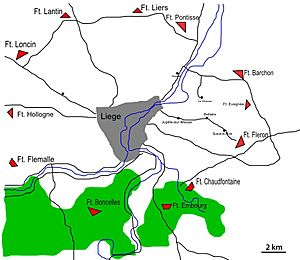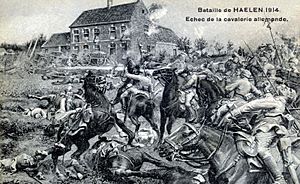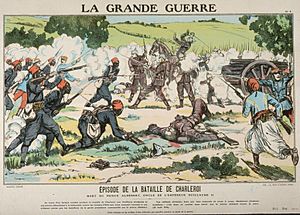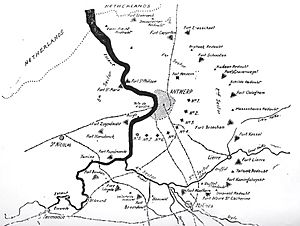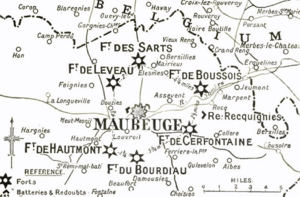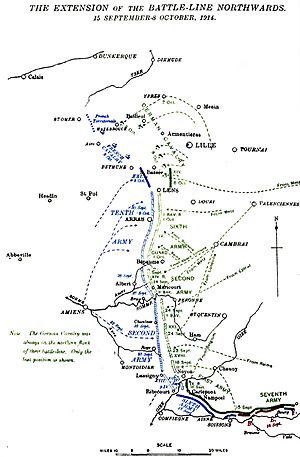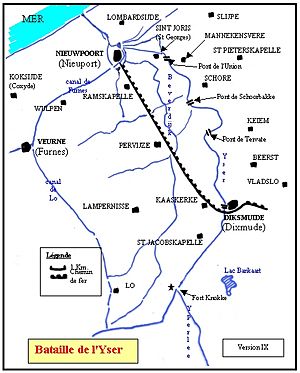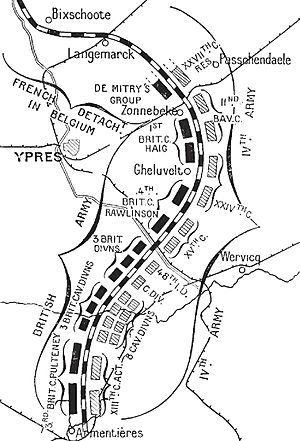German invasion of Belgium (1914) facts for kids
The German invasion of Belgium was a major military event that started on August 4, 1914. It marked the beginning of the First World War on the Western Front. Belgium had declared itself neutral, meaning it wouldn't take sides in a war. But Germany sent an ultimatum on August 2, demanding to march its troops through Belgium to attack France. Belgium refused, and the United Kingdom promised to help Belgium if Germany invaded. Germany declared war on Belgium on August 4, and its troops crossed the border, starting the Battle of Liège.
Quick facts for kids German invasion of Belgium |
|||||||||
|---|---|---|---|---|---|---|---|---|---|
| Part of the Western Front of the First World War | |||||||||
 German invasion of Belgium |
|||||||||
|
|||||||||
| Belligerents | |||||||||
Supported by: |
|
||||||||
| Commanders and leaders | |||||||||
| Strength | |||||||||
| 750,000 men | Belgium: 220,000 men France: 299,000 men UK: 247,400 men Total: 766,400 men |
||||||||
| Casualties and losses | |||||||||
| 20,000 | 30,000 | ||||||||
| 6,000 civilians killed in the ... Belgium | |||||||||
After the city of Liège fell on August 7, the Germans moved to besiege other Belgian forts along the Meuse river, like Namur. The Belgian government left its capital, Brussels, on August 17. The Belgian army then moved west to a strong defensive area near Antwerp. Brussels was taken by Germany on August 20.
Most German armies then marched south into France. They left smaller forces behind to guard Brussels and the railways. The Belgian army tried to attack German supply lines from Antwerp. This helped the French and British armies by keeping German troops busy in Belgium.
Contents
- Why Germany Invaded Belgium
- War Breaks Out
- Key Battles
- Battle of Liège (August 4–16)
- Battle of Halen (August 12)
- Siege of Namur (August 20–24)
- Battles of Charleroi and Mons (August 21–23)
- Siege of Antwerp (September 28 – October 10)
- Other Operations (August–October)
- Race to the Sea (September 17 – October 19)
- Battle of the Yser (October 16 – November 2)
- First Battle of Ypres (October 19 – November 22)
- Aftermath
Why Germany Invaded Belgium
Belgium's Neutrality
Belgium's neutrality was set up by major European countries in 1830. The Treaty of London in 1839 officially recognized Belgium as an independent and neutral country. Before 1914, Belgium thought Germany would attack France directly. But British and French promises to protect Belgium made some Belgians wonder if their neutrality was just a tool for other countries.
In 1911, a crisis made it clear that a European war and a German invasion of Belgium were possible. Belgium decided it had to be ready to fight back. This was to avoid being accused of helping either Britain or France. Belgium also continued to see Britain, France, and the Netherlands as possible enemies.
Germany asked Belgium in 1913 and 1914 about moving troops through its land. If invaded, Belgium would need foreign help. But it would not become an ally or have goals beyond keeping its independence. This neutrality meant Belgium had to build up its own military. A rearmament plan started in 1909, aiming to be finished by 1926.
German War Plans: The Schlieffen Plan
Germany's main war plan was called the Schlieffen Plan. It focused on attacking France first and quickly. The idea was to avoid France's strong border defenses. German forces would quickly move through Belgium, then attack France from the north. This would allow them to win a decisive victory.
After defeating France, Germany would then turn its attention to fighting Russia in the east. This plan meant Germany would have fewer troops ready for the Eastern Front at the start of the war.
French War Plans: Plan XVII
France's war plan was called Plan XVII. It involved gathering five armies near the German border. France had more railway lines to the German border than Germany did. This meant France could wait to see what Germany would do.
The French expected Germany to attack through Lorraine or southern Belgium. Plan XVII was updated to prepare for a German attack through Belgium from the north. There were no formal plans for combined operations with the British. But arrangements had been made for British troops to operate near Maubeuge.
War Breaks Out
On June 28, 1914, Archduke Franz Ferdinand of Austria was assassinated. This event quickly led to a series of declarations of war. On July 23, Austria-Hungary sent an ultimatum to Serbia. Belgium declared it would defend its neutrality.
On August 2, Germany sent an ultimatum to Belgium. It demanded permission to move troops through Belgian territory. German troops also crossed into Luxembourg that day. On August 3, Belgium refused Germany's demands. The British government promised military support to Belgium if Germany invaded.
Germany declared war on France. On August 4, the British government sent an ultimatum to Germany. When Germany did not respond, Britain declared war on Germany at midnight. Belgium also broke off relations with Germany, and Germany declared war on Belgium. German troops then crossed the Belgian border and attacked the city of Liège.
Key Battles
Battle of Liège (August 4–16)
The Battle of Liège was the first major fight of World War I. The German attack on Liège began on August 5. It lasted until August 16, when the last fort surrendered. This battle caused Britain to declare war on Germany. The long siege may have delayed Germany's invasion of France by a few days.
The German armies were able to continue their advance by August 17. However, they did not appear in force before Namur until August 20. The Belgian army moved away from the Gete river towards Antwerp. Brussels was captured without a fight on August 20. The siege of Liège lasted eleven days, much longer than Germany expected.
Battle of Halen (August 12)
The Battle of Halen was fought on August 12, 1914. It involved German and Belgian forces. The Belgian cavalry division was sent to guard a bridge over the Gete river at Halen. The Belgian general staff told their troops to fight on foot. This helped to reduce Germany's numerical advantage.
Belgian engineers blew up the bridge over the Gete. But it only partly collapsed, allowing about 1,000 German troops into Halen. The Germans were confident after taking Halen easily. They made several poorly planned attacks on the Belgian position. By the end of the day, the Germans had to retreat. This battle was a Belgian victory, but it didn't change the overall war strategy much.
Siege of Namur (August 20–24)
Namur was defended by a ring of modern forts. The siege began on August 20. The Germans waited for their heavy artillery to arrive from Liège. They then bombarded the forts before attacking with infantry. French troops sent to help Namur were defeated at the Battle of Charleroi.
The forts were destroyed by the bombardment. Most of the Belgian 4th Division retreated south. The remaining Belgian troops were forced to surrender on August 24. The Belgians held off the Germans for several days longer than expected. This gave Belgium and France more time to get their armies ready.
Battles of Charleroi and Mons (August 21–23)
The Battle of Charleroi was fought on August 21, 1914. French and German forces clashed as part of the Battle of the Frontiers. The French Fifth Army was planning an attack. But the Germans attacked first, forcing the French to retreat. This retreat stopped the Germans from completely surrounding the French army.
At the Battle of Mons, British forces tried to hold a canal line against the German 1st Army. They caused heavy losses to the Germans. But they had to retreat when some units were overrun. The French Fifth Army on their right also withdrew. Both sides had some success. The British held off the Germans for 48 hours. The Germans were delayed but advanced into France.
Siege of Antwerp (September 28 – October 10)
At the fortified city of Antwerp, German troops surrounded Belgian forces and some British troops. The city was protected by a ring of forts. The Germans began bombarding these forts with heavy artillery on September 28. The Belgian forces had little hope without help. Even with British reinforcements, the Germans broke through the outer forts.
The Germans began to close off the escape route from the city. The Belgian army started to withdraw west towards the coast. On October 9, the remaining Belgian forces surrendered. The Germans occupied Antwerp. Some British and Belgian troops escaped to the Netherlands. The operations to save Antwerp failed. But they kept German troops busy when they were needed elsewhere.
Other Operations (August–October)
Belgian resistance and German fears led to harsh treatment of Belgian civilians. After the Battle of the Sambre, French and British forces retreated. The French fortress of Maubeuge was ordered to be defended. It was surrounded by German forces on August 27. Maubeuge blocked a key railway line.
On August 29, the Germans began bombarding the forts around Maubeuge. On September 5, German infantry stormed four forts. The garrison surrendered on September 7. The Germans captured 40,000 prisoners and many guns. The fall of Maubeuge helped the Germans move supplies and troops.
British air and marine forces also operated in Belgium. On August 27, British aircraft flew reconnaissance missions. British marines landed in France in September. They scouted unoccupied Belgium in armored cars. More British naval divisions arrived in October. Naval forces were gathered to form the Dover Patrol. This unit operated in the English Channel and off the French-Belgian coast.
Race to the Sea (September 17 – October 19)
The "Race to the Sea" happened from September 17 to October 19, 1914. After the Battle of the Marne, both French-British and German armies tried to outflank each other. This meant they tried to get around the enemy's northern end. This extended the front line northwards towards the coast.
Troops were moved from the eastern parts of the front to the west. Both sides wanted to stop the enemy from outflanking them. They also wanted to try to outflank the enemy themselves. This led to battles in Picardy, Artois, and Flanders. The "race" ended on the North Sea coast of Belgium around October 19. The last open area was filled by Belgian troops who had retreated from Antwerp.
Battle of the Yser (October 16 – November 2)
The Battle of the Yser took place in October 1914 along the Yser river in Belgium. About 50,000 Belgian troops took up positions between Nieuwpoort and Diksmuide. This marked the end of the "Race to the Sea." Germany formed a new 4th Army to attack the Belgians.
On October 16, King Albert ordered that retreating soldiers would be shot. The Belgian army was very tired and low on supplies. A German attack began on October 18. By October 22, the Germans had crossed the Yser river. The Belgians were pushed back to a railway embankment.
On October 27, sluice gates at Nieuwpoort were opened. This began the flooding of the coastal plain. A German attack on October 30 crossed the embankment but was forced back. On November 2, Diksmuide was captured by the Germans.
First Battle of Ypres (October 19 – November 22)
The First Battle of Ypres began on October 19. German armies attacked at the same time as the British Expeditionary Force (BEF). German attacks were costly but pushed back British cavalry. On October 31, the British defense of Gheluvelt nearly collapsed. But a counter-attack pushed the Germans back.
By November 1, the BEF was very tired and had lost many soldiers. French troops were moved north to help. German attacks began to slow down by November 3. A new German attack was planned for November 10. This attack led to the loss of Diksmuide by the Franco-Belgian forces. On November 11, the British faced a huge bombardment and an attack by Prussian Guard troops. They broke into British positions but were forced back.
Aftermath
By November 1914, the war plans of both France and Germany had failed. Most of Belgium was under German occupation. A German military government was set up on August 26, 1914. Belgium was divided into three zones by the Germans.
The German invasion of Belgium led to battles like Charleroi and Mons. These were followed by a quick retreat to the Marne river, where the German advance was stopped. Both sides then tried to outflank each other, moving the main armies north. The siege of Antwerp ended, and costly battles like the Yser and Ypres followed.
By November 10, the German high command knew that no major success could be expected on the Western Front. German troops were tired, and they were low on heavy artillery ammunition. The German army in the west was ordered to dig in and defend its gains. This allowed Germany to focus on the worsening situation on the Eastern Front. The German occupation of Belgium lasted until late 1918.



